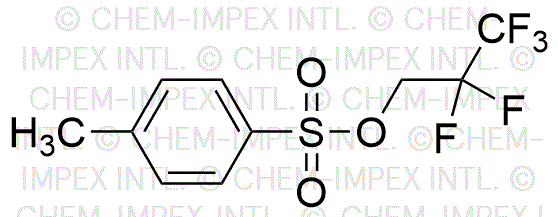2,2,3,3,3-Pentafluoropropyl p-toluenesulfonate is widely utilized in research focused on:
- Fluorinated Polymer Synthesis: This compound serves as a key reagent in the production of fluorinated polymers, which are known for their chemical resistance and thermal stability, making them ideal for use in coatings and advanced materials.
- Pharmaceutical Development: It is used in the synthesis of various pharmaceutical intermediates, enhancing the efficacy and stability of drug formulations, particularly in the development of fluorinated compounds that can improve bioavailability.
- Surface Modification: The chemical is applied in the modification of surfaces to create hydrophobic or oleophobic properties, which are beneficial in industries such as textiles and electronics, improving product performance and longevity.
- Environmental Applications: It is utilized in the development of environmentally friendly solvents and surfactants, contributing to greener chemistry practices by reducing the environmental impact of chemical processes.
- Analytical Chemistry: This compound is employed as a derivatizing agent in analytical methods, enhancing the detection and quantification of various analytes in complex mixtures, which is crucial for quality control in manufacturing.
General Information
Properties
Safety and Regulations
Applications
2,2,3,3,3-Pentafluoropropyl p-toluenesulfonate is widely utilized in research focused on:
- Fluorinated Polymer Synthesis: This compound serves as a key reagent in the production of fluorinated polymers, which are known for their chemical resistance and thermal stability, making them ideal for use in coatings and advanced materials.
- Pharmaceutical Development: It is used in the synthesis of various pharmaceutical intermediates, enhancing the efficacy and stability of drug formulations, particularly in the development of fluorinated compounds that can improve bioavailability.
- Surface Modification: The chemical is applied in the modification of surfaces to create hydrophobic or oleophobic properties, which are beneficial in industries such as textiles and electronics, improving product performance and longevity.
- Environmental Applications: It is utilized in the development of environmentally friendly solvents and surfactants, contributing to greener chemistry practices by reducing the environmental impact of chemical processes.
- Analytical Chemistry: This compound is employed as a derivatizing agent in analytical methods, enhancing the detection and quantification of various analytes in complex mixtures, which is crucial for quality control in manufacturing.
Documents
Safety Data Sheets (SDS)
The SDS provides comprehensive safety information on handling, storage, and disposal of the product.
Product Specification (PS)
The PS provides a comprehensive breakdown of the product’s properties, including chemical composition, physical state, purity, and storage requirements. It also details acceptable quality ranges and the product's intended applications.
Certificates of Analysis (COA)
Search for Certificates of Analysis (COA) by entering the products Lot Number. Lot and Batch Numbers can be found on a product’s label following the words ‘Lot’ or ‘Batch’.
Número de catálogo
Número de lote/lote
Certificates Of Origin (COO)
This COO confirms the country where the product was manufactured, and also details the materials and components used in it and whether it is derived from natural, synthetic, or other specific sources. This certificate may be required for customs, trade, and regulatory compliance.
Número de catálogo
Número de lote/lote
Safety Data Sheets (SDS)
The SDS provides comprehensive safety information on handling, storage, and disposal of the product.
DownloadProduct Specification (PS)
The PS provides a comprehensive breakdown of the product’s properties, including chemical composition, physical state, purity, and storage requirements. It also details acceptable quality ranges and the product's intended applications.
DownloadCertificates of Analysis (COA)
Search for Certificates of Analysis (COA) by entering the products Lot Number. Lot and Batch Numbers can be found on a product’s label following the words ‘Lot’ or ‘Batch’.
Número de catálogo
Número de lote/lote
Certificates Of Origin (COO)
This COO confirms the country where the product was manufactured, and also details the materials and components used in it and whether it is derived from natural, synthetic, or other specific sources. This certificate may be required for customs, trade, and regulatory compliance.

